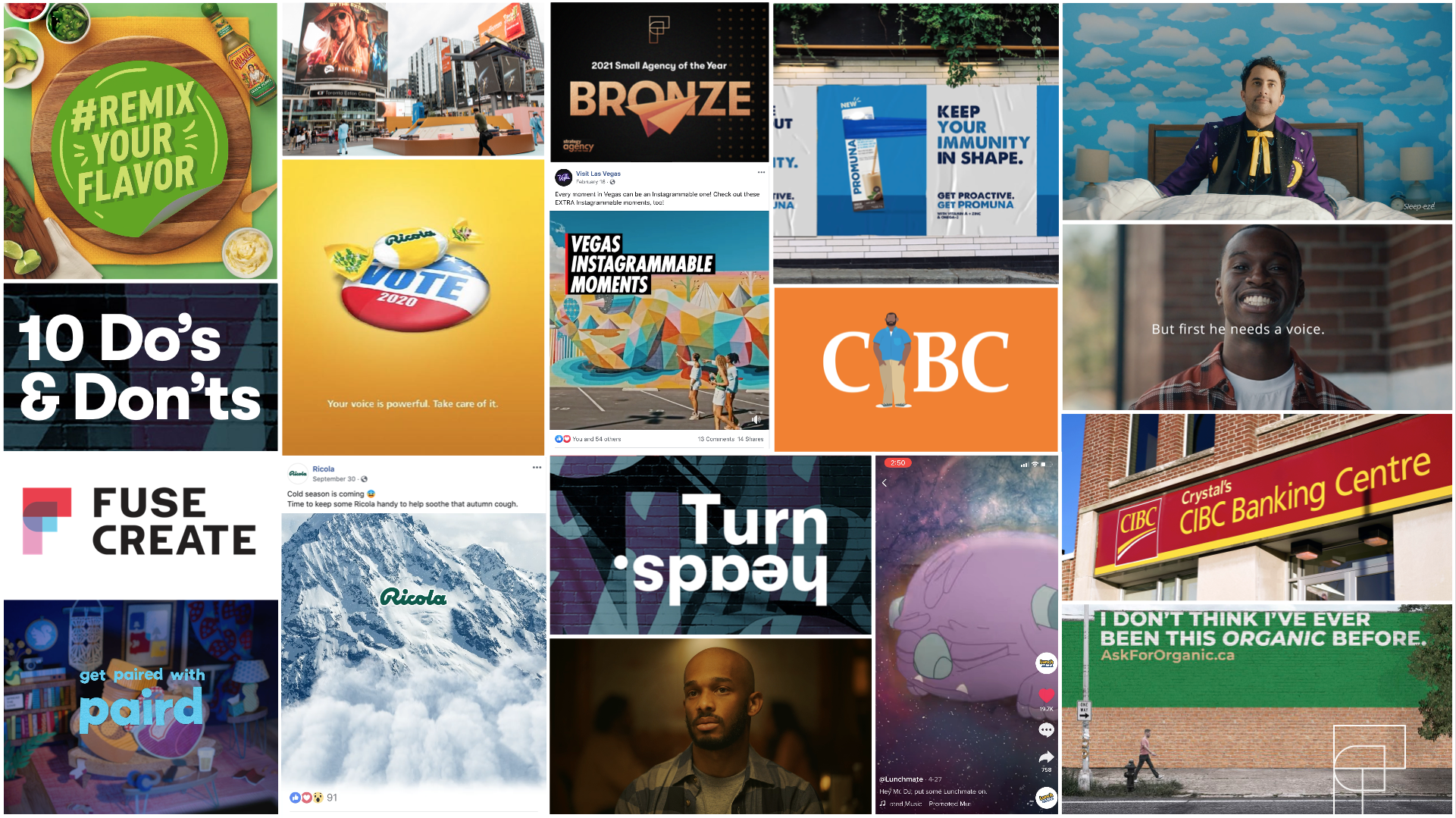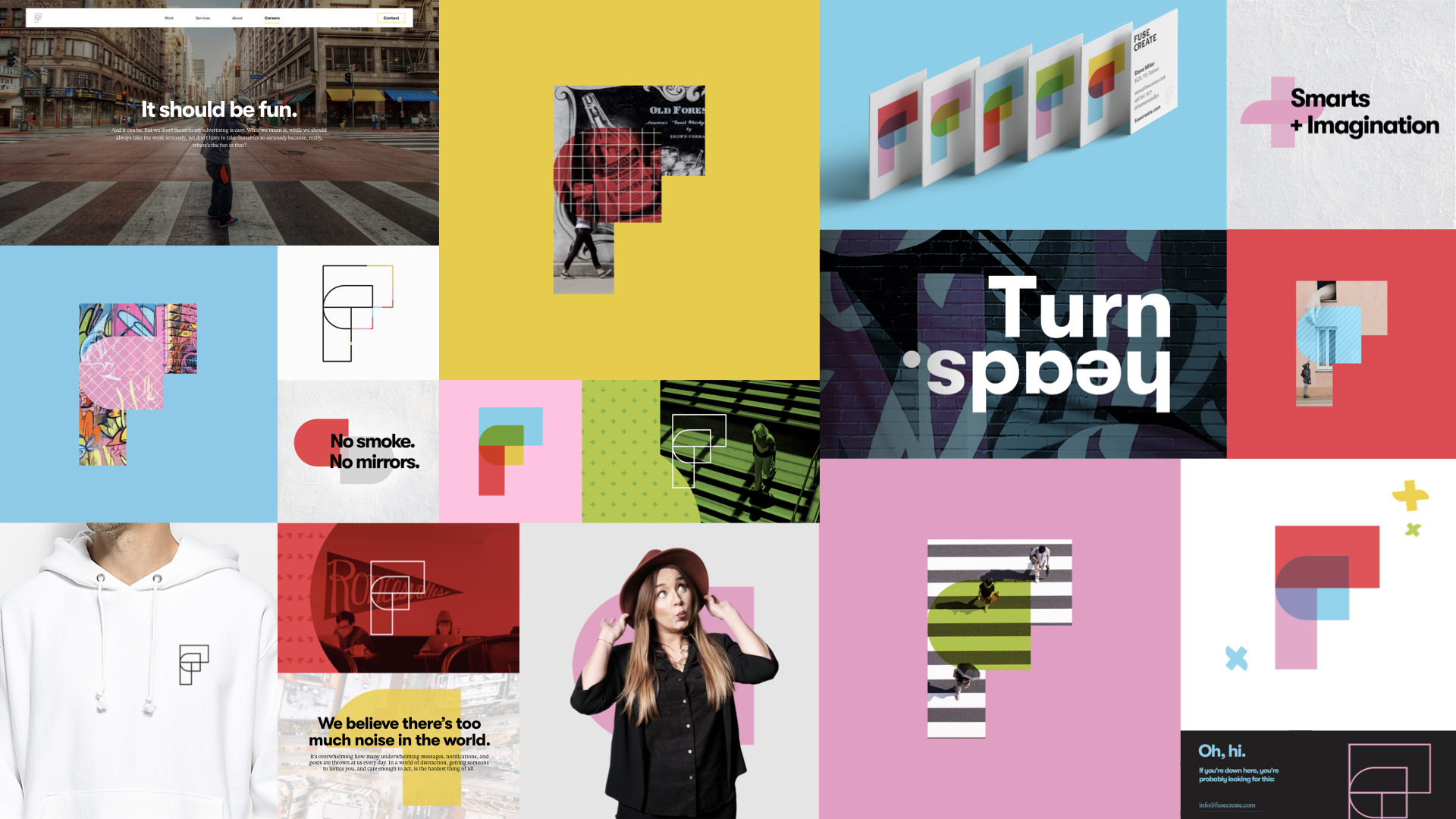
10 DO’s & DON’Ts in creating an agency culture that thrives, and wins.
To get to award-winning work, clients that look like heroes, and impassioned staff, you need a culture that thrives - we did it in less than three years. Here’s how.

In less than three years, we took FUSE Create from off the radar, to being one of the top three small agencies in Canada. The work had a lot to do with it. But three years ago, the work was just good – the challenge was, how do we get to great?
Great work is a by-product of a great culture – that’s how.
So, we set out to redefine our culture. To give the agency, and everyone who works here, a purpose. To bring on people with equal parts talent + positivity. And to ensure our collected focus was on the work. Because when you have a culture that thrives – one that is full of energy and camaraderie, one that is supportive and nurturing, and one that is united and impassioned – then your people, your clients, the agency, and yes the work, thrives too.
The following 10 Do’s & Don’ts are a simple roadmap of how we redefined our culture, created a portfolio of award-winning work, grew our clients’ business, and found our place amongst the top three small agencies in Canada.
1. DO surround yourself with Possibilitarians.
Culture is the lifeblood of an agency. And when I say “culture”, I don’t mean foosball and brightly painted walls. I’m talking about the literal definition of the term; the attitudes and behaviour characteristics of a particular social group. Culture is nothing without the people who bring the right attitude and who embody the right behaviours. And the best kind of people are Possibilitarians.
It’s not my word, but it’s my favourite word (thank you Dr. Norman Vincent Peale). And the perfect word to describe the kind of person an agency culture thrives under. A Possibilitarian is someone who is equal parts positive-attitude and believer that anything is possible. They pour their glass half-full, and grey is their favourite colour because for them, nothing is black and white. They are natural collaborators, ardent champions, infectiously optimistic, and steadfast naysayers of the response “no” and “can’t”. And they celebrate the losses as much as the wins, that’s key.
It’s those kinds of positive, possibility-believing people across all departments that define a culture, and in the process, nurture creativity and awards (if that’s your thing), and each other. Because ultimately, you don’t hire Art Directors, Designers, Strategists or Business Leads, you hire people. And the best kind of people, are Possibilitarians.
2. DON’T let egos through the door.
They’re the worst. Egos get in the way of everything – at least everything to do with building the kind of agency culture that produces the best work, and the best environment to produce said best work. Egos thwart collaboration, breed unhealthy competition, and turn their nose up at generally being good peeps. Honestly 🙄.
Confidence is a must in this business. You need to believe in yourself to have a thick skin. And you need to bring conviction and passion to get the most original and innovative ideas through. You need all those things, but you don’t need to do it with an air of egotism; ego is just conceit trying to pass itself off as confidence. So, don’t let egos get in the way of great work and a great culture, by not letting them through the door.
3. DO leave three bullet points at the end of a job description…
Roles in any organization are often outlined in a job description. It typically lists the duties, responsibilities, and tasks to be performed, and the manner in which to perform them. And the list of bullet-pointed functions is seemingly finite; it has a beginning, middle, and most egregiously, an end. But what we contribute to an organization is never finite, so why are our responsibilities?
That’s why I leave three empty bullet points at the end of any job description. It’s shorthand for ‘chip in’, ‘roll up your sleeves’, and ‘be prepared to wear many hats’. It’s an invitation on the organization’s behalf to contribute in as many ways as possible – in any way really – to the success of the agency, from within your role, or even outside. And when that happens, proactiveness, teamwork, learning, and equality flourish.
It’s a philosophy of expectations and a wonderful signal of what’s expected. A simple addition to a job description that at first glance might look like a mistake, but there is quite literally no mistaking the positive impact it can have on an agency’s culture, and the infinite growth it can lead to in an employee. Those three vacant bullet points are there to empower and inspire; they’re each a little black oyster to a world of possibilities.
4. DON’T bring personal agendas to the office.
After the great fire of 1666 in London, England, the famous architect Christopher Wren was commissioned to rebuild St Paul’s Cathedral. During the rebuild, Christopher observed three bricklayers on the jobsite. He asked the first bricklayer, “What are you doing?” to which the bricklayer replied, “I’m laying bricks.” The second bricklayer responded with, “I’m earning a living.” When Christopher asked the third bricklayer the same question, the bricklayer paused, and then said, “I’m building a cathedral.”

I love this allegory. It perfectly embodies the mindset and perspective we should all have as we help build our ‘cathedrals’, and not just our resumés. One’s focus should be on the collective agenda of making the agency amazing, not simply one’s self. Everyone needs to be rowing in the same direction and singing from the same hymn book – if just one person isn’t, the paddling gets tougher and the hymn sounds out of tune.
The problem is that selfishness suggests you’re only buying into you. Whereas selflessness suggests you’re buying into the greater you; your colleagues, your manager, your agency, its vision, its raison d’être, or as Simon Sinek puts it, its “just cause”. Ladder climbing and resume building take the focus away from the heights with which the agency can climb. And when everyone is looking down from the top, everyone’s resume will build itself.
Liberating your agency from personal agendas doesn’t result in the purging of mentorship or career growth – that’s still present and important. It simply means putting the agency’s agenda first, and right-sizing priorities from how will ‘I’ benefit, to how will ‘we’ benefit. When the agency is successful, so too will the employee. Aristotle was no dummy; the whole truly is greater than the sum of its parts. So, say “No” to personal agendas, it will rid you of your occupational sins.
5. DO adopt a creative-driven mindset (versus a profit-driven one).
Now hear me out… The difference between an agency driven by profit and one driven by creativity is rooted in the motivations of its leaders. It sets the tone for the agency, its employees, client relationships, and ultimately the product. The agency becomes fundamentally defined by that mindset and as a result, so too its viability, competitiveness, and long-term success, in an industry whose product is creative.
The choices you make are determined by your motivations. So, if profit is #1, then theoretically, everything else is #2, including award-winning work, and the motivation to create it. In a profit-driven organization, you make decisions influenced greatly by economics. These often parsimonious choices can run counterintuitive to an organization whose product is creativity; they can seemingly have an inverse relationship to one and other.
A profit-driven mindset affects an agency’s value system and leaks into the lexicon of its culture. Functionality, Efficiency and Productivity become the consideration set, versus Creativity, Inspiration, and Innovation. That kind of economics-motivated value system permeates throughout an agency and all of its touch points, from purchasing cheap desks and chairs to scrimping on hours needed to produce great work. It also affects the clients you go after – you seek those that reflect positively on the balance sheet rather than the brief, clients that build your bottom line rather than your agency’s portfolio, reputation, and credibility. It rewards short-term thinking to be efficient, versus long-term brand-building to be effective. Don’t get me wrong, a creative-driven agency still has to make a profit, but they’re not driven by profit; making a profit is very different than being driven by it.
Making a profit is the by-product of something else; it’s incidental, it’s secondary to the thing you do. Driven is to say it’s the very thing you do; it’s primary, it’s your motivation. The phrase “Do what you love, and the money will follow” doesn’t work when profit is the motivating factor – the thing you ‘love’. If that were the case, then the phrase would simply be “Do money.” But what we do is creative. That’s what needs to be primary. That’s what needs to be the collective motivation of the agency, and that’s why we need to adopt a creative-driven mindset. Otherwise, what are we all doing this for anyway? 🤔
6. DON’T think in terms of black and white, always think in the grey.
Ok, sometimes think in terms of black and white – ask any PM and they’ll tell you it’s always black and white. But a creative culture shines in the grey, oddly enough. It feeds off the new, the unexpected, and the unknown. People and a culture need to be ok with a little grey – yes, even the PMs (especially the PMs). There needs to be room for flexibility in a media plan, a budget, or a timeline. A ‘roll with the punches’ mentality. The ability and fervor to pivot on an idea, and the willingness to change any second, because technology can change in an instant.
For example, the creative team might come up with a better idea the day before a pitch. Or a strategist might discover a new and more relevant insight. Or Instagram might launch a new engagement opportunity. The black and white minded person says, “Too late”, “Too difficult”, and “Too expensive”. But if you’re in the grey, you say, “I’ll see if I can move the pitch date”, “How quickly can we get this in front of the client?”, and “Maybe we can turn this into a Test & Learn”. They offer solutions. They say yes first and ask questions later. I love the grey.
Beth Comstock, the great innovation leader at GE put it as having to learn to be comfortable with some level of “maybe”. The grey can be scary. “Maybe” can be scary too. But where there’s risk, there’s reward.
7. DO collaborate, and then do it some more.
Two heads are better than one – the math doesn’t lie. And that adage doesn’t just apply to smarts, it applies to quality of work and also the camaraderie an agency feels when you collaborate. Because when you have the belief and willingness to do so, you build connections, unity, a team mentality, and a family feel for the agency. Not to mention you’ll probably have more fun in the process, and you might just get the work done in half the time – as they say, many hands/heads make light work.
And if we think of our contribution to an agency as 51% reflective of our title and 49% reflective of our talent, collaboration becomes even more influential on a culture, and overall success of an agency. And if we’re following points 1, 2, 3, and 8, then collaboration will come naturally, often, and even when you least expect it. Besides, when you collaborate, sharing in the successes and in the failures is often sweeter and less painful, respectively.
The idea of collaboration extends beyond the desks and halls of the agency. Instead of working with photographers, production houses, artists, illustrators, and musicians, collaborate with them. Treat them like partners, not vendors. Keep and share that same belief in collaboration with an openness, willingness, and humility. When you do, the outcome is always everyone and everything being better for it. As a little bird once told me; teamwork makes the dreamwork.
8. DON’T add different levels of seniority to your titles.
Senior. Intermediate. Junior (I prefer “Inexperienced”). Sure, indicating seniority might look good on a business card (do people still use those?), but it doesn’t look good on an org chart. Why? Because this type of social stratification within a team creates hierarchy, precedence, jealousy, privilege, and hesitation.
The value in these types of titles are individualistic, so that becomes the focus. Employees get pre-occupied with the pursuit of their next title versus the pursuit of their next big idea. In other words; they lose focus when they focus on themselves. By doing away with rank in titles, you do away with senior employees dismissively saying “That’s not my job!” and junior employees lamenting “That’s not my job 😞.” Removing that added layer creates a level playing field and gives way to equality which in turn encourages support, collaboration, respect, and fewer arguments.
Experience is everything. There will still be a natural selection when it comes to the distribution of jobs and projects. And if common sense prevails, the appropriate experience will be matched with the appropriate complexity of a job (and compensation). And colleagues should be respectful of that experience. But all of that can happen without rank or entitle, and as a result, without drama. If you wanna call yourself “Senior Copywriter” on LinkedIN, knock yourself out, but internally, stick to “Copywriter”.
9. DO put your name on your agency’s front door.
My father used to say that if I had to sweep the floor, make it the cleanest floor anyone’s ever walked on. Or if I had to mow the lawn, make it the envy of golf course groundskeepers. His message was that there is no job too insignificant not to give it your all – not because you’d get in trouble or have to do it over again, but because it was a reflection of you.
At the office, if you think it’s your name on the door rather than the agency’s, I guarantee you’ll approach your work differently. You’ll spend just a little more time finessing that layout, crafting that copy, or reviewing those animations in the presentation, because it’s yours, not ‘theirs’. There is a greater sense of ownership that comes with that perspective, and with that, a greater sense of accountability and responsibility, and also pride.
If everyone thinks that way, if everyone owns their work as if they own the agency, not only will the trust in each other increase, but so too will the quality of the work. After all, it’s your name on the door.
10. DON’T make your clients happy.
It’s easy to make your clients happy, you just give them what they want. No questions asked. They’re happy, you’re happy, because well, you made them happy, I guess. But our job shouldn’t be to simply make our clients happy; our job ought to be to make them look like heroes. Help them shine within their ranks. And that takes hard work because what they want, isn’t necessarily always what they need.
Giving them what they need means we have to interrogate their ask rather than just accept it. We may need to push back on timelines, budgets, and/or feedback if the idea demands it. Push one more time for the agency recommendation if it’s right for the brand. Have difficult conversations. And if need be, be proactive in educating clients on what great work looks like. And all of that takes time, effort, critical thinking, persistence, ingenuity, and patience, not to mention bravery. And none of that is easy. But if we do that, clients won’t just be happy, in the end, they’ll be ecstatic. As Teddy Roosevelt famously said, “Nothing in the world is worth having or worth doing unless it means effort, pain, difficulty…” Hear hear Teddy.
The path of least resistance leads to mediocrity, contentment, and a minimum viable creative product – it ekes out client happiness. The path of most reward leads to pride, excellence, and the best possible creative product (sounds like a thriving culture…) – it over delivers on client happiness and makes them look like a hero in the process.
Culture. It unequivocally defines, shapes, and determines the course for an agency. It fuels the work. It feeds the souls of its people. And it can take an agency from good, to great.


